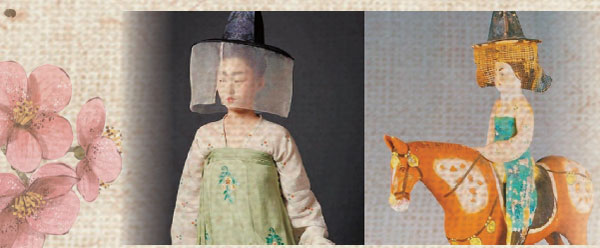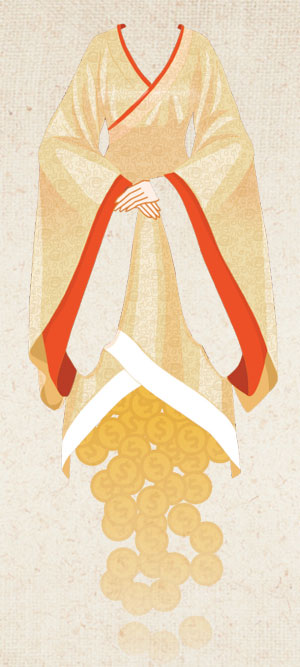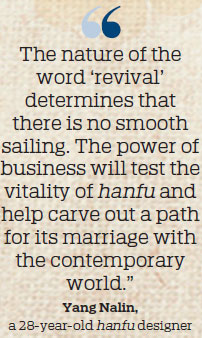Entrepreneurs thrive on revival of traditional Han Chinese garb
Updated: 2019-05-31 06:47
By Luo Weiteng(HK Edition)
|
|||||||
Hanfu, the ancient clothing of China's Han ethnic group, has seen a resurgence as the country's young people seek to connect to the past. The growth of e-commerce has helped connect buyers and sellers in the fledgling market, as Luo Weiteng reports.
Like many grassroots entrepreneurs, Yang Nalin saw her business get off to a bumpy start amid questions like, "Why don't you have a real job?"
When she dished out thousands of dollars to open an online store on e-commerce platform Taobao with her friends back in 2012, joining the gold rush in China's online shopping craze was nothing new. However, being an online store owner specializing in hanfu - the ancient Chinese clothing style that had faded into history and was unfamiliar to most modern Chinese people - was deemed as a job that could barely earn her a living in those days.

Almost seven years later, the once-little-known traditional Chinese clothing is experiencing a popular revival as young consumers increasingly favor items that are unique, artistic, and linked to a rich historical legacy. Such a revival today is more than a social phenomenon itself. As one of the most sought-after niche fashion markets in China, hanfu has the business potential to make hundreds of hanfu online stores like Yang's survive and thrive.
After the first several years, everything got on track. Yang's online store rakes in nearly 90,000 yuan ($13,040) in profits annually. Though that figure pales in comparison to leading stores like Guangzhou's Han Shang Hua Lian and Chengdu's Chong Hui Han Tang, whose sales in a single month go well beyond 10 million yuan, the 29-year-old designer, with a stint of optimism, said, "At least I manage to feed myself."
She continued: "Now, the voices of doubt eventually fade away. After all, not everyone could have the luck to have their personal interest and a means of livelihood perfectly combined. Hanfu is where my interest lies. It is also where my bread and butter comes from"
A peek into Han culture
Hanfu - literally, "clothes of China's ethnic Han majority" - takes its name from the Han Dynasty (206 BC-AD 220). It is said to have been invented by the Yellow Emperor, or Huangdi - described in archaic annals as the founder of China's 5,000-year-old civilization.
Though styles changed over time, standards of dress and the corresponding etiquette system lasted thousands of years before the Manchu emperors since the 17th century, and then waves of Western and Japanese imperialists imposed their own styles on the Han Chinese - who make up more than 90 percent of the country's population.

What may come as a surprise is that quite a number of people nowadays are actually willing to spend money on such garments that they have few occasions to wear. But there is certainly strength in numbers.
According to Taobao's 2019 China Fashion Trend Report, released in March, hanfu has been the third most searched keyword among female shoppers in 2019 so far. It also finds a place among the top 10 searches for male shoppers.
Such findings underscore the backbone status of young women in the ancient Chinese clothing fad. An industry report published on internet portal Sohu depicts them as mostly in their 20s and known for their keen interest in traditional Chinese culture, as well as their strong desire to spend money on it.
As public data showed, the top 10 hanfu stores on Taobao, led by Han Shang Hua Lian, made 98 million yuan in transactions in April this year, up 385 percent from the previous year.
"Popularity is no longer a big issue," Yang said. "E-commerce has spread the trend, making it easy for shops to reach hanfu enthusiasts even in small towns miles away."
Hanfu fans on the community site Baidu Tieba alone now almost exceed 1 million, compared with no more than 700,000 at the beginning of 2017. That's a relatively small fraction of the country's 1.39 billion population. But according to an industry estimate, about 92 percent of hanfu devotees choose to buy their garments from stores rather than making it themselves or having it made. This paves the way for online sales growth at a blistering pace.
Despite all the hype, Yang pointed out that for small and midsize online hanfu stores, what remains as a real issue today is the lack of production capacity.
As one of the most salient features of hanfu, the flat pattern-cutting makes the clothes wide and loose, so the wearer both looks and feels comfortable, but also underlines the need for the attire to be tailor-made. This reduces the utilization rate of fabrics, and extends the production period, Yang said.
Labor of Love
Jiang Yifei, a manager at a telecommunication company in Chengdu and a longtime hanfu buyer, said, "The production period of hanfu is notoriously long. For some popular items, it's quite normal to wait more than a year to get your order eventually done and delivered."
Only a few big stores have the capacity to offer the "quick-done" items in the standard sizes of "small", "medium" and "large", like what people can find from the high-fashion retailers. The time for tailor making a garment is still a must, but the amount of time is much more acceptable.
Yet, Yang believed it is no easy task to strike a delicate balance between mass production and standards of dress characterized by flat-pattern cutting. Compromise is inevitable.
"The question is, to what extent can we surrender our standards to make hanfu accessible to a wider public and regain vitality in the modern world?" asked Zong Nan, an editor of a website that promotes reviving traditional Chinese culture.
As the hanfu craze catches on in China, the community is crowded with newcomers, some of whom are eager to add another piece of beautiful clothing to their wardrobes without much care for culture behind the Chinese couture. For them, the long production period tests their patience, while the high price tags test their wallets.
There is no shortage of affordable brands in which most hanfu outfits cost 500 to 800 yuan. Still, some newcomers would be scared away or turn to cheaper, "crudely made" ones.
"Here is a dilemma. Hanfu-making is a time-consuming and handwork-intensive process that requires craftsmanship and meticulously chosen fabrics. This makes quality of the clothes and price really hard to compromise," Zong said. "But you cannot shy away from the fact that not everyone believes the clothing is worth that much."
Citing Ming Hua Tang, the most high-end hanfu brand dedicated to making outfits modeled on Ming dynasty dresses, Zong pointed to the market segmentation.
Registered in Hong Kong back in 2009 and based in Guangzhou, the brand has no Taobao store, with few people even knowing much about its media-shy, Hong Kong-born founder. An outfit under the brand of Ming Hua Tang is normally priced at 6,000 yuan or even higher. Buyers on the waiting list are many, so much so that the latest batch of orders won't be processed until August 2020.
"A high-quality piece of hanfu makes the living embodiment of the astonishing aesthetics of traditional Chinese cultures," Jiang said. "Even people outside the hanfu community will not scrimp on admiring oohs and aahs for the clothes. Those crudely made garments at a rock-bottom price only reinforce people's stereotype that we are filming a show or holding a costume party."
But she said she believes ordinary people on a tight budget also look to get a taste of the clothing. "At the heart of all activities of reviving the ancient Chinese garb is the pursuit of making our ethic Han majority take pride in putting on the clothes that we were forced to take off centuries ago. Prices should not raise the bar too high," she said.
Giving it a modern twist
Much of the compromise is due to the fact that most debates go without better answers. Above all, followers and fans differ over whether they are purely into the thrills of wearing the clothes or drawn to the ancient values and ethnic assertion. This gave rise to the years-long argument on whether and how much hanfu could be modified.

"'Hanfu reformists insist that the attires should be modified to fit modern tastes, while 'hanfu fundamentalists' resist altering the clothes to suit modern needs," said Zhao Mingbo, a hanfu researcher committed to making the clothes based on available historical materials and unearthed artworks.
"The point is how much modification is acceptable," Zhao said. "Modification at an appropriate level may help integrate the clothes into people's daily life. But too much modification will make us fall into the trap of inventing the history and tradition of hanfu."
"The market itself allows for compromise and modification. True enough," Yang pointed out. "But even the most reformist online store owners take their cues from historical materials and unearthed artworks for new arrivals on the shelves. Without those people who take the clothes seriously and make every single piece in a research attitude, we are nothing but retro-style dressers entertaining ourselves."
Amid the hustle and bustle of the so-called hanfu economy, the vitality of the Chinese couture lies in a broader revival of traditional Chinese rituals. Schools now often parade students in ancient scholar gowns for coming-of-age and graduation ceremonies. Young couples embrace hanfu costumes as an option for traditional wedding ceremonies, said Yao Yuan, founder of Han Wei Yang, a Shanghai-based NGO promoting traditional hanfu cultures.
More and more people wear the clothes to celebrate traditional Chinese festivals, and redefine some important moments of their lives, such as family reunions and new-born baby parties. "There is a long journey ahead for hanfu amassing broader, everyday appeal and reshaping China's view on what is beautiful and fashionable. We are well underway," Yao said.
Today, the core clientele of Yang's store still hasn't grown beyond the community of cosplayers and classics connoisseurs. But having witnessed the growing influence of hanfu over a mere decade, Yang believed it is all about the future and young generation.
"The nature of the word 'revival' determines that there is no smooth sailing. The power of business will test the vitality of hanfu and help carve out a path for its marriage with the contemporary world," Yang said.
Contact the writer at sophia@chinadailyhk.com
(HK Edition 05/31/2019 page10)